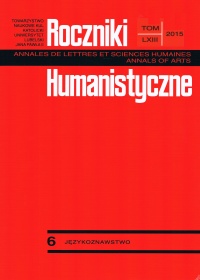Witness Statement – an Old Official Genre as the Evidence of the Legal Order
Abstract
The Witness Statement as a genre of official style of a documentary nature has been considered in the article to be old, because its formation was not a long process, lasting in the Polish language from the early 19th century, when it was introduced with the legal regulations of the Napoleonic Code, until 1945. This is one of personal status certificates that was drawn up in connection with the modern process of marriage formalization, constituting evidence of the old legal and social order and the impact of French culture. Formally, it served as a birth certificate and for this reason was subject to the rules of textual substitution of a pragmatic function, while references to the prototext became an essential textual component of the analyzed statements.
The textual pattern of the nineteenth-century Witness Statement, presented in the article, formed not only on the basis of the intertextual relationship with the birth certificate, but also as a result of the influence of the architecture of old official documents, formed through the centuries. It adapted also genre-specific structural segments, the most important of which was the statement of the witnesses. Due to the circumstances of the formation and functioning of the genre, textual embodiments were characterized by some freedom relative to the textual pattern reconstructed in the study, nevertheless text standardization progressed with time.
References
Borawski S.: Wprowadzenie do historii języka polskiego, Warszawa 2000.
Dunin-Dudkowska A.: Akt notarialny jako gatunek wypowiedzi, Lublin 2010.
Dziennik praw, t. I, Warszawa 1810.
Gajda S.: Intertekstualność a współczesna lingwistyka, w: Intertekstualność we współczesnej komunikacji językowej, red. J. Mazur, A. Małyska, K. Sobstyl, Lublin 2010, s. 13-23.
Kuć J.: Akty uszanowania i pozwolenia na zawarcie małżeństwa jako umowy intertekstualne, „Białostockie Archiwum Językowe” 2012, nr 12, s. 91-98.
Kuć J.: Polszczyzna łukowskich aktów notarialnych z początku XIX wieku, Siedlce 2013.
Malinowska E.: O stałości i zmienności gatunków urzędowych, w: Gatunki mowy i ich ewolucja, t. I: Mowy piękno wielorakie, red. D. Ostaszewska, Katowice 2000, s. 86-95.
Markiewicz H.: Literaturoznawstwo i jego sąsiedztwa, Warszawa 1989.
O aktach stanu cywilnego. Pismo… dla użytku osób utrzymujących akta stanu cywilnego ułożone, Warszawa 1858.
Pawiński M.: Akta stanu cywilnego w Królestwie Polskim w pierwszej połowie XIX wieku, „Archeion” 104(2002), s. 203-220.
Rejter A.: Genologia historyczna a stylistyka. Zarys problematyki, „Stylistka” 20(2011), s. 193-211.
Siuciak M.: Średniowieczny dyskurs prawny – czyli o początkach stylu urzędowego, w: Odmiany stylowe polszczyzny dawniej i dziś, red. U. Sokólska, Białystok 2011, s. 285-297.
Sójka-Zielińska K.: Kodeks Napoleona. Historia i współczesność, Warszawa 2007.
Szkutnik P.: Regionalny poradnik genealogiczny – treść oraz przydatność do badań metryk i akt stanu cywilnego parafii rzymskokatolickiej w gminie Uniejów, „Biuletyn Uniejowski” 2(2013), s. 125-137.
Wilkoń A.: Spójność i struktura tekstu, Kraków 2002.
Witosz B.: Genologia lingwistyczna. Zarys problematyki, Katowice 2005.
Wojtak M.: Styl urzędowy, w: Współczesny język polski, red. J. Bartmiński, Lublin 2001, s. 155-171.
Wojtak M.: Gatunki urzędowe na tle innych typów piśmiennictwa użytkowego, w: Język – prawo – społeczeństwo, red. E. Malinowska, Opole 2004, s. 131-141.
Woźniak E.: Prawdy i mity o języku urzędowym w dobie nowopolskiej, referat wygłoszony na konferencji „W kręgu dawnej polszczyzny”, Kraków, grudzień 2014.
Zdunkiewicz-Jedynak D.: Język w polskim Kościele katolickim początku XXI wieku: przegląd najważniejszych zjawisk, w: Język polski jako narzędzie komunikacji we współczesnym świecie, red. J. Mazur, M. Rzeszutko-Iwan, Lublin 2007, s. 115-129.
Copyright (c) 2015 Roczniki Humanistyczne

This work is licensed under a Creative Commons Attribution-NonCommercial-NoDerivatives 4.0 International License.





